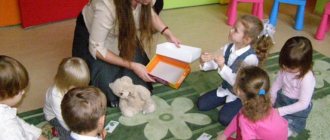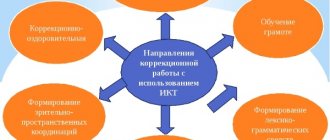The importance of tempo-rhythms in speech therapy
In persons with speech disorders, the sense of rhythm and motor function are impaired. Therefore, conducting speech therapy rhythms for children with speech disorders is one of the mandatory areas in correctional work. How to characterize rhythm in speech therapy? This is an opportunity not only to hear, but also to repeat after an adult a sequence of movements over a certain period of time.
How is rhythm characterized in speech therapy? Psychology has long proven that any rhythmic movements have a beneficial effect on brain activity. All this affects cognitive activity, the emotional-volitional sphere and the development of speech.
What is logorhythmics
It is an integral part of kinesitherapy. During logorhythmic classes, specially selected exercises are combined with the pronunciation of certain speech material.
The nature of speech disorders determines what the main task of speech therapy rhythm is. With the help of her methods, a comprehensive correction of both speech and other disorders associated with them occurs based on the complex use of rhythmic movements, words and music.
Logorhythmic exercises
Important! As a result of regular classes, it is planned not only to correct speech functions, but also to develop the physical and mental qualities of children and adapt to environmental conditions. In children, on this basis, there is a restructuring of the motor, sensory, speech-motor, and cardiovascular systems, and the development of emotional and volitional personality traits.
Even children who do not speak at an early age get a chance to fully develop.
Speech therapy rhythms for children with speech disorders
Answering the question why speech therapy rhythm is especially important, experts argue that the education of a tempo-rhythmic sense has a beneficial effect not only on general and finger motor skills, but also on the quality of articulatory patterns. As a result of logorhythmic exercises, the child:
- coordination of movements improves;
- the spatio-temporal organization of movements is formed;
- musical perception improves;
- articulatory motor skills are improved;
- the prosodic aspect of speech improves;
- the desired sound is automated;
- interhemispheric connections are formed.
Note! Classes on speech therapy rhythms for children with speech disorders are conducted separately, and some of their elements are included in other lessons as physical training. Speech material should be selected based on the age characteristics of the child.
Description of "Merry Logorhythmics"
One of the most popular techniques in this area is the complex developed by Sergei and Ekaterina Zheleznov. The exercises are a combination of music and speech therapy chants. The authors recommend training 3–4 times a week for 15–20 minutes.
The lesson begins with walking and running to musical accompaniment. Then they perform several exercises to develop the motor sphere. The final stage is speech exercises and chanting, which are best supplemented with finger gymnastics (“Bunny”, “Goat”, “Sparrow”, “Tit”, etc.).
The set includes audio CDs, which are the basis of the lessons. But a specialist can select other audio tracks and play them online. During the first lessons, the child is introduced to the game material: he listens to the soundtrack and repeats the movements after the adult. After several lessons, the speech therapist focuses on the quality of the movements performed.
At the final stage, the child is asked to come up with his own movements to the music track. For logorhythmic lessons to be effective, the adult must actively participate. During classes you need to use visual material.
The main signs of speech underdevelopment in a preschooler
Important! When the child masters the movements, they are replaced with new, more complex ones.
Features of sound automation in syllables
Speech therapy chants for non-speaking children are one of the effective ways to consolidate phonemes in syllables. In addition to correcting sound pronunciation, they simultaneously work on intonation and speech breathing. Warehouse chants have a beneficial effect on articulatory motor skills. Speech exercises should be accompanied by finger exercises.
Such chants should be carried out with children from an early age. An adult can help repeat the movements, and classes take place at a pace that is comfortable for the baby. Older children perform all actions independently. This is clapping your hands, tapping a certain rhythmic pattern.
They can be offered a task to “read” syllables: after hearing and singing a certain syllable, the child simultaneously taps the card with the syllable. Or you can do this activity as a board game. All pure sayings are spoken to the music. The melodies are simple, so children can play them independently based on the notes. Singing develops the prosodic side of speech, a sense of rhythm and forms interhemispheric connections of the brain.
Movement and motor skills
Movement is one of the main features that characterize living beings. Movement becomes more perfect as the living world develops. It is believed that it was man who reached the maximum degree of development of movement, because his body is the best self-regulating system that interacts with the environment.
Movement is a balancing mechanism in a system that operates on the “organism-environment” principle. A person not only comes into harmony with his environment, but knows how to adapt to it. Moreover, the process of adaptation is interesting in that a person not only improves and changes himself, but also makes adjustments to his very environment in the process of adapting to it.
Thus, the movement of man is very different from the movement of all other living beings. A person acts consciously. His movements are determined not only by biological needs, but also by social ones. Movement also becomes for him a means of preventing diseases, curing them and rehabilitating them after them.
There is also the concept of “motor skill”. This is such a degree of mastery of a certain movement at which a person is focused on the correct execution of all elements of this movement.
Speech therapy chants
They are one of the main methods of working with children with complex speech defects. To work with them, they use a set of exercises proposed by Novikova-Ivantsova. It is easier for kids to perceive rhyming phrases, and music has a beneficial effect on the nervous system. This all increases the effectiveness of classes.
All work is based on the ontogenetic principle of the appearance of sounds in children's speech. Alaliks are characterized by impaired pronunciation of vowels, and singing them helps to form the correct acoustic image. These exercises are convenient for practicing the ability to control the pitch of your voice. It also forms correct speech breathing.
Important! In addition to the structure of the defect, the age of the child is taken into account when selecting speech material.
Features of working with children 3–4 years old
During this period, speech is characterized by the formation of the following groups of sounds:
- labiolabial;
- labiodental;
- posterior lingual;
- front-lingual.
The child begins to master the pronunciation of whistling and hissing sounds. Children with speech disorders may have difficulty pronouncing these groups of sounds.
Examples of speech therapy chants for children 3–4 years old for back-lingual phonemes:
- KOO-KOO-KOO - the rooster crowed;
- GU-GU-GU - geese walk in the meadow;
- GI-GI-GI - quickly run to the meadow;
- KI-KI-KI - horses and bulls walk.
Examples of chants for whistlers:
- FOR-ZA-ZA – I have a goat;
- SA-SA-SA - a wasp flew to us;
- ZU-ZU-ZU – I brought home a goat;
- CO-CO-CO - pumped up the tire.
Examples of chants for hissing ones:
- ZHU-ZHU-ZHU – I’ll look at the beetle;
- SHU-SHU-SHU - I’ll go up to the baby;
- ZHA-ZHA-ZHA - brought home a hedgehog;
- SHA-SHA-SHA - how good the weather is.
Speech therapy session on the topic “Professions” for different ages
Note! These chants can be used in classes with children 3–4 years old. For greater effectiveness, be sure to use toys and pictures.
Features of working with children 5–6 years old
The sound-pronunciation side of speech at this age is characterized by the formation of hissing and sonorant groups. The exercises are made more complex by adding alternation of paired consonants and increasing the size of the material to short poems.
Examples of singing for a sonorous group:
- RA-RA-RA - it’s time for the children;
- RO-RO-RO - the rooster lost his feather;
- RU-RU-RU - I’ll pick all the berries;
- LO-LO-LO - all the roads are covered with snow;
- LI-LI-LI - the cranes flew away.
Examples of alternating chants:
- LA-RA-LA-RA - Lara helped Roma;
- ZHI-SHI-ZHI-SHI - all candies are good.
Important! It should be remembered that speech therapy chants are only one of the ways to automate and form prosody. This type of work is a priority for children who stutter. This is due to a feature of the defect: a violation of the tempo-rhythmic aspect of speech. Logorhythmics helps to correct it.
Motor skill and its formation
A motor skill is a degree of mastery of a certain movement in which all actions are performed automatically and carried out correctly. Despite the fact that a person has mastered some motor skill, he is able to consciously perform this motor action.
Consciousness is involved in order to achieve the task, in order to control the movements performed, in order to get rid of automation if the conditions for completing the task have changed.
The formation of a motor skill is the development of a stereotype during the interaction of the first signaling system with the second. Moreover, the second system prevails. Research has shown that there is an inextricable connection between the formation of psychomotor and motor skills.
There are such a huge number of relationships between these components of a person’s personality that psychomotor development began to be used in relation to both normal development and pathological development.
At the first stage of his development, a person experiences the world through the movements performed by the body and the perception of the sensations received.
A person explores auditory, gustatory, visual and other sensations, which forms his first ideas about the world. This level of cognition is simpler than the intellectual level.
Efficiency of classes
For an activity to be effective, it must be regular. The combination of movements and speech exercises allows for parallel work in several directions:
- improvement of the entire motor sphere;
- correction of sound pronunciation and phonetic-phonemic processes;
- normalization of the emotional-volitional sphere.
Note! After classes, children better coordinate their movements and orient themselves in space; the quality of differentiated movements of finger motor skills increases.
Speech becomes more expressive, diction improves, and its pace normalizes. Automation of sounds is more efficient. And properly selected musical accompaniment normalizes the state of the nervous system, which has a beneficial effect on brain activity.
Efficiency and effectiveness of this method
As a result of logorhythmic exercises, the following tasks are solved:
- Children gain the ability to articulate sounds more accurately.
- They improve their phonemic awareness.
- As a result of the development of the speech sphere, the vocabulary increases.
- When conducting logorhythmic exercises, auditory attention improves and motor memory strengthens.
- Under the guidance of a speech therapist, general and fine motor skills develop, which is closely related to the improvement of the child’s thinking.
- The baby learns to perform clear coordinated movements in accordance with the spoken speech.
- Improving the melodic-intonation characteristics of speech.
- Development of children's creative imagination.
Exercises for speech development in children 2-3 years old
With regular exercise, the effect will be greatest.
Diagnosis of young children
A speech therapist is most often consulted when a child turns 3 years old. But the earlier correctional work is started, the more effective it will be. A speech therapy examination carried out with young children will allow you to see a complete picture of speech development. Parents should pay attention to the state of the motor sphere:
- can the baby stand on one leg;
- on the quality of jumping and running in place;
- how a child holds a pencil and makes appliqués;
- can he repeat the rhythmic pattern?
If the baby is awkward, tries to avoid tasks that require subtle differentiated movements with his fingers (cutting, appliqué), and cannot repeat the rhythm, this may be a sign of a speech disorder. If by the age of one and a half years he does not speak and uses mainly facial expressions and gestures, it is worth contacting a specialist.
Modern technologies of speech therapy for young children make it possible to correct speech disorders as much as possible. The work is based on the formation of the correct pronunciation of vowels, labial-labial, labial-dental, back-lingual and front-lingual sounds. All exercises should be supplemented with finger exercises. All this will have a beneficial effect on the state of the motor sphere and the development of children's speech.
Logorhythmic exercises
Game “Walk” (development of gross motor skills)
Along a narrow path
(walking in place)
Our legs walk
(raising our legs high)
Over pebbles, over pebbles
(shuffle from foot to foot at a slow pace)
And into the hole... bang!
(sit on the floor on the last word)
Game “Big and Small Drops” (developing a sense of tempo and rhythm)
The adult tells the child that it is raining. For clarity, you can turn on the corresponding audio recording and listen to it with your eyes closed for 10-15 seconds. How do big drops knock? That's right, they knock slowly - drip, drip, drip, drip... What about small droplets? Of course, quickly! Drip-drip-drip-drip-drip-drip... The child’s task is to pronounce the text, clapping his hands on his knees in given rhythms.
Game "Orchestra" (development of auditory attention)
When an adult says “Rain!” - the child says: “Sh-sh-sh...” in response to “Lightning!” - rings the bell, and hearing “Thunder!” - Stomps his feet loudly. At the word “Silence” everything goes silent.
Finger game "House"
(development of fine motor skills) There is a house in a clearing
(the fingers of both hands are widely spaced at an angle to each other, only the fingertips are touching)
Well, the path to the house is closed
(the thumbs of both hands are raised up, the remaining fingers are in a horizontal position together, the tips of the middle fingers fingers touch)
We open the gates and invite you into this house.
(palms turn parallel to each other, arms spread to the sides with palms up)
Singing (training breathing, voice and fluency of speech)
Choose any song and sing it with your child, even if you think the bear has stepped on both of your ears.
Author:
Teacher speech therapist
Ainetdinova Rufiya Myainovna
GBOU secondary school No. 21
structural unit No. 57
Syzran






